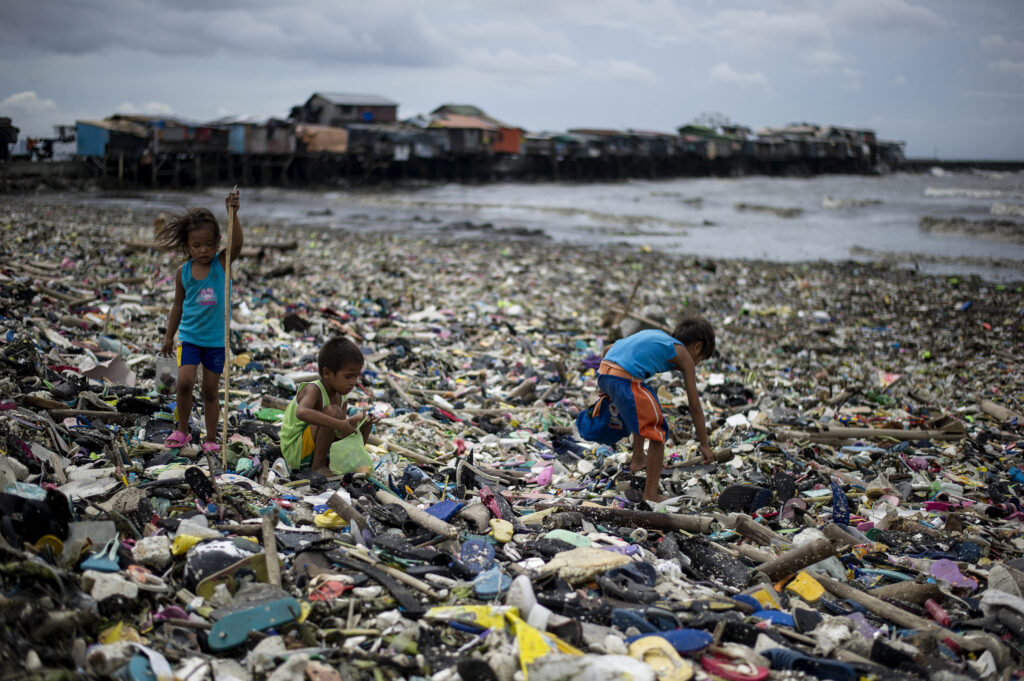
FILE: Children collect plastic water bottles among the garbage washed ashore as a result of a storm surge of typhoon Haima at the Manila Bay on October 20, 2016. | Photo by NOEL CELIS / AFP
Weather disasters fueled by climate change — from floods to droughts, storms to wildfires — sparked 43.1 million child displacements from 2016 to 2021, the UN Children’s Fund warned Thursday, October 5, 2023, slamming the lack of attention paid to victims.
In a sweeping report on the issue, the United Nations agency detailed the heart-wrenching stories of some of the children affected, and co-author Laura Healy told AFP the data only revealed the “tip of the iceberg,” with many more likely affected.
“We moved our belongings to the highway, where we lived for weeks,” recounts Sudanese child Khalid Abdul Azim, whose flooded village was only accessible by boat.
In 2017, sisters Mia and Maia Bravo watched flames engulf their trailer in California from the back of the family minivan.
READ MORE: World felt hottest September on record, this year expected to be hottest in human history—EU monitor
“I was afraid, in shock,” Maia says in the report. “I would stay up all night.”
Statistics on internal displacements caused by climate disasters generally do not account for the age of the victims.
But UNICEF worked with the non-governmental Internal Displacement Monitoring Center to unpick the data and reveal the hidden toll on children.
From 2016 to 2021, four types of climate disasters (floods, storms, droughts and wildfires) — the frequency of which has increased due to global warming — led to 43.1 million child displacements in 44 countries, the report says.
Ninety-five percent of those displacements were caused by floods and storms.
“It’s the equivalent of about 20,000 child displacements every day,” Healy told AFP, underscoring how the children affected are then at risk of suffering other traumas, such as being separated from their parents or falling victim to child traffickers.
READ MORE: Climate nears point of no return as land, sea temperatures break records -experts
The data reflect the number of displacements and not the number of children affected, as the same child could be uprooted more than once.
The figures do not allow for a distinction between those evacuated before a weather event, and those forced to leave in the wake of a disaster.
And, according to Healy, the number of displacements due to drought is “radically underreported,” because they are less sudden and thus more difficult to quantify.
“This is just the tip of the iceberg based on the available data that we have,” she said.
“The reality is with the impacts of climate change, or better tracking of displacement when it comes to slow onset events, that the number of children who are uprooted from their homes is going to be much greater.”
‘Far too slowly’
The UNICEF report offers some partial predictions, for specific events.
Floods linked to overflowing rivers could spark 96 million child displacements in the next 30 years, while cyclonic winds could force 10.3 million displacements, it says. Storms surges could lead to 7.2 million displacements.
None of those estimates include preventive evacuations.
“For those who are forced to flee, the fear and impact can be especially devastating, with worry of whether they will return home, resume school, or be forced to move again,” UNICEF Executive Director Catherine Russell said in a statement.
“Moving may have saved their lives, but it’s also very disruptive,” Russell said.
“As the impacts of climate change escalate, so too will climate-driven movement. We have the tools and knowledge to respond to this escalating challenge for children, but we are acting far too slowly.”
READ MORE: Unicef points out effects of missing in-person classes on Filipino kids
UNICEF called on world leaders to take up the issue at the COP28 climate summit in Dubai in November and December.
Healy says children, including those already forced to move, must be prepared “to live in a climate change world.”
Even if the intensifying effects of climate change are affecting wide swathes of the planet, the UNICEF report shines the light on particularly vulnerable countries.
China, India and the Philippines are the countries with the largest number of displacements (nearly 23 million in six years) because of their huge populations and their geographic locations — but also because of their preventive evacuation plans.
But in proportional terms, Africa and small island nations are most at risk — in Dominica, 76 percent of all children were displaced from 2016 to 2021. For Cuba and Saint-Martin, that figure was more than 30 percent.